
|
Now it is very bright as 8.2 mag (Nov. 11, Michael Mattiazzo). It will approach to Sun down to 0.4 a.u. on Dec. 13, and it is expected to brighten up to 6 mag. It stays observable while the comet is brightening until late November when it brightens up to 7 mag.
Date(TT) R.A. (2000) Decl. Delta r Elong. m1 Best Time(A, h)
Nov. 14 11 59.25 -16 21.5 1.048 0.818 47 8.2 5:06 (309, 20)
Nov. 21 12 58.81 -20 15.9 1.041 0.683 39 7.4 5:12 (307, 13)
|
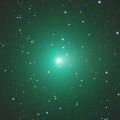
|
Now it is very bright as 7.5 mag (Nov. 11, Osamu Miyazaki). It stays observable at 8 mag in excellent condition from October to November.
Date(TT) R.A. (2000) Decl. Delta r Elong. m1 Best Time(A, h)
Nov. 14 5 26.07 3 55.9 0.358 1.301 145 8.0 1:54 ( 0, 59)
Nov. 21 5 27.03 13 11.8 0.365 1.327 155 8.2 1:27 ( 0, 68)
|

|
Now it is 9.4 mag (Nov. 10, Chris Wyatt). It stays observable in the evening low sky after this while it will be getting fainter gradually.
Date(TT) R.A. (2000) Decl. Delta r Elong. m1 Best Time(A, h)
Nov. 14 19 38.91 -25 23.3 1.658 1.454 60 9.5 18:22 ( 33, 22)
Nov. 21 20 4.74 -24 11.5 1.716 1.483 59 9.8 18:19 ( 34, 23)
|

|
Brightened rapidly. Now it is very bright as 10.3 mag (Nov. 10, Chris Wyatt). It is observable at 10-11 mag in excellent condition from October to November.
Date(TT) R.A. (2000) Decl. Delta r Elong. m1 Best Time(A, h)
Nov. 14 23 40.45 -4 24.1 0.513 1.334 121 11.1 20:05 ( 0, 51)
Nov. 21 23 48.37 1 7.6 0.538 1.334 118 11.2 19:46 ( 0, 57)
|

|
It brightened up to 13.5 mag in summer (July 31, Ken-ichi Kadota). It is expected to brighten up to 12 mag from autumn to winter. In the Southern Hemisphere, it will appear in the morning sky in December, then it stays observable in good condition. In the Northern Hemisphere, it will be observable in the extremely low sky only from November to December.
Date(TT) R.A. (2000) Decl. Delta r Elong. m1 Best Time(A, h)
Nov. 14 13 40.02 -12 3.4 2.574 1.721 24 12.7 5:06 (288, 5)
Nov. 21 13 46.96 -15 51.8 2.510 1.711 28 12.6 5:12 (295, 7)
|

|
First return of a new periodic comet which brightened up to 13 mag in 2009. Now it is bright as 13.4 mag (Nov. 9, Toshihiko Ikemura, Hirohisa Sato). It is expected to brighten up to 12 mag and to be observable in excellent condition in winter.
Date(TT) R.A. (2000) Decl. Delta r Elong. m1 Best Time(A, h)
Nov. 14 4 17.91 -12 55.6 0.460 1.393 145 13.2 0:45 ( 0, 42)
Nov. 21 4 20.81 -13 14.3 0.433 1.368 145 12.9 0:21 ( 0, 42)
|
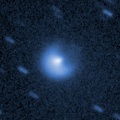
|
Now it is 14.4 mag (Nov. 5, Sandor Szabo).
Date(TT) R.A. (2000) Decl. Delta r Elong. m1 Best Time(A, h)
Nov. 14 2 28.16 26 29.6 4.872 5.836 165 13.2 22:52 ( 0, 82)
Nov. 21 2 24.89 26 10.4 4.899 5.838 160 13.2 22:21 ( 0, 81)
|
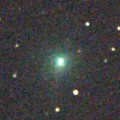
|
Now it is 12.5 mag (Oct. 28, Michael Jager). In the Northern Hemisphere, appearing in the morning sky. It stasy observable after this while the comet will be fading rapidly. In the Southern Hemipshere, it will never be observable again.
Date(TT) R.A. (2000) Decl. Delta r Elong. m1 Best Time(A, h)
Nov. 14 14 16.94 9 25.0 1.381 0.744 31 13.4 5:06 (265, 10)
Nov. 21 14 34.12 8 37.2 1.522 0.888 33 14.4 5:12 (268, 13)
|

|
Now it is 11.2 mag (Sept. 11, Carlos Labordena). Now it is not observable. It will appear in the morning sky at 14.5 mag.
Date(TT) R.A. (2000) Decl. Delta r Elong. m1 Best Time(A, h)
Nov. 14 15 52.90 -18 17.7 3.900 2.924 8 13.5 18:22 ( 75,-11)
Nov. 21 16 1.98 -19 38.9 3.976 2.991 3 13.7 18:19 ( 76,-15)
|
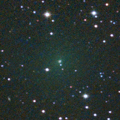
|
Brightened very rapidly. Now it is very bright as 13.4 mag (Nov. 6, Michael Jager). It approaches to Earth down to 0.5 a.u. in November, and it is observable in excellent condition.
Date(TT) R.A. (2000) Decl. Delta r Elong. m1 Best Time(A, h)
Nov. 14 0 12.15 17 11.8 0.503 1.395 135 13.7 20:38 ( 0, 72)
Nov. 21 0 27.44 14 34.4 0.517 1.390 132 13.5 20:25 ( 0, 70)
|
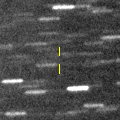
|
It will brighten very rapidly, and will brighten up to 11 mag from December to January. It stays observable for a long time. In the Southern Hemipshere, it locates low until the high light. Actually it was reported much fainter than this ephemeris, too faint to detect recently.
Date(TT) R.A. (2000) Decl. Delta r Elong. m1 Best Time(A, h)
Nov. 14 19 2.26 -10 37.3 1.089 0.960 54 14.6 18:22 ( 50, 29)
Nov. 21 19 25.48 -10 27.0 1.025 0.906 53 13.9 18:19 ( 51, 29)
|

|
It approached to Sun down to 0.29 a.u. on July 3, and it brightened up to 0.6 mag (Alan Hale). Now it is fading. It has faded down to 11.3 mag in September (Sept. 27, Mitsunori Tsumura). Now it is not observable. It will appear in the morning sky at 16 mag.
Date(TT) R.A. (2000) Decl. Delta r Elong. m1 Best Time(A, h)
Nov. 14 15 49.65 -18 56.2 3.583 2.606 7 14.0 18:22 ( 75,-12)
Nov. 21 15 55.99 -19 41.2 3.691 2.704 2 14.3 18:19 ( 77,-16)
|
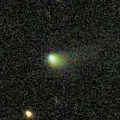
|
It stays 13-14 mag from 2020 to 2021. It is not observable until January.
Date(TT) R.A. (2000) Decl. Delta r Elong. m1 Best Time(A, h)
Nov. 14 15 26.56 -13 17.9 3.899 2.916 5 14.4 18:22 ( 83,-14)
Nov. 21 15 37.96 -14 16.9 3.889 2.909 5 14.4 5:12 (278,-13)
|
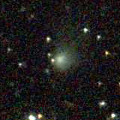
|
Now it is 14.8 mag (Oct. 18, Toshihiko Ikemura, Hirohisa Sato). It is expected to be observable at 5-6 mag for a long time from 2022 to 2023. In the Northern Hemisphere, it is not observable at the high light from 2022 summer to 2023 summer. In the Southern Hemisphere, it is not observable now. But it will be observable in good condition at the high light.
Date(TT) R.A. (2000) Decl. Delta r Elong. m1 Best Time(A, h)
Nov. 14 17 24.08 37 41.2 8.202 7.808 63 14.5 18:22 (114, 36)
Nov. 21 17 27.91 37 5.8 8.173 7.755 61 14.5 18:19 (115, 32)
|
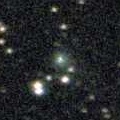
|
Now it is 13.9 mag (Nov. 9, Toshihiko Ikemura, Hirohisa Sato). It will brighten up to 12 mag in winter in 2022. In the Northern Hemisphere, it stays observable in good condition for a long time. In the Southern Hemisphere, it is not observable until 2021 November.
Date(TT) R.A. (2000) Decl. Delta r Elong. m1 Best Time(A, h)
Nov. 14 23 56.29 63 18.3 4.523 5.136 123 14.6 20:21 (180, 62)
Nov. 21 23 54.75 62 27.2 4.499 5.094 122 14.5 19:52 (180, 62)
|
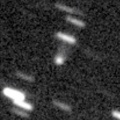
|
Now it is 14.8 mag (May 14, Toshiyuki Takahashi). It will brighten up to 13 mag in 2021. In the Southern Hemisphere, it becomes too low to observe temporarily from mid October to mid December. In the Northern Hemisphere, it is not observable until July in 2022.
Date(TT) R.A. (2000) Decl. Delta r Elong. m1 Best Time(A, h)
Nov. 14 15 12.80 -37 55.3 5.024 4.107 19 14.6 5:06 (299,-27)
Nov. 21 15 21.55 -39 5.7 4.992 4.077 19 14.6 5:12 (303,-23)
|

|
Now it is 14.3 mag (Nov. 5, Sandor Szabo). In the Northern Hemisphere, it stays observable for a long time while it is getting fainter slowly. In the Southern Hemisphere, it will never be observable again.
Date(TT) R.A. (2000) Decl. Delta r Elong. m1 Best Time(A, h)
Nov. 14 15 33.37 61 19.2 4.727 4.651 79 15.2 18:22 (147, 27)
Nov. 21 15 41.94 60 42.3 4.755 4.696 80 15.2 5:12 (213, 27)
|
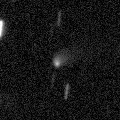
|
Now it is 14.9 mag (Oct. 13, Chris Wyatt). It stays 14-15 mag until 2021. In the Southern Hemisphere, it stays observable in good condition for a long time. In the Northern Hemisphere, it is not observable until June in 2021.
Date(TT) R.A. (2000) Decl. Delta r Elong. m1 Best Time(A, h)
Nov. 14 19 3.41 -64 55.0 4.876 4.458 59 15.2 18:22 ( 18,-15)
Nov. 21 19 19.16 -63 41.1 4.916 4.444 56 15.2 18:19 ( 19,-15)
|

|
Now it is 14.9 mag (Oct. 10, Chris Wyatt). It will brighten up to 13.5 mag in spring in 2021. In the Southern Hemisphere, it stays observable in good condition for a long time. In the Northern Hemisphere, it is not observable until spring in 2021.
Date(TT) R.A. (2000) Decl. Delta r Elong. m1 Best Time(A, h)
Nov. 14 17 19.46 -46 42.5 4.385 3.655 37 15.3 18:22 ( 41,-13)
Nov. 21 17 22.23 -45 53.5 4.423 3.630 32 15.3 18:19 ( 44,-15)
|
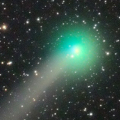
|
It brightened up to 6.0 mag in June (June 13, Marco Goiato). Now it is fading. It has already faded down to 14.5 mag (Oct. 18, Toshihiko Ikemura, Hirohisa Sato). In the Northern Hemisphere, it stays observable for a long time until it fades out. In the Southern Hemisphere, it will never be observable again.
Date(TT) R.A. (2000) Decl. Delta r Elong. m1 Best Time(A, h)
Nov. 14 17 58.85 23 27.6 2.873 2.483 57 15.4 18:22 ( 94, 38)
Nov. 21 18 12.66 23 42.5 2.981 2.568 56 15.7 18:19 ( 96, 36)
|
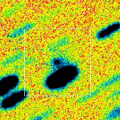
|
Now it is 16.3 mag (Oct. 29, ATLAS-MLO, Mauna Loa). It brightens up to 15 mag in winter. But it is not observable at high light. In the Southern Hemisphere, it stays observable in good condition until autumn when the comet will brighten up to 16 mag. It stays locating very low in the Northern Hemisphere.
Date(TT) R.A. (2000) Decl. Delta r Elong. m1 Best Time(A, h)
Nov. 14 19 37.67 -25 5.3 2.529 2.213 60 15.6 18:22 ( 34, 22)
Nov. 21 19 50.83 -23 46.8 2.582 2.196 56 15.5 18:19 ( 37, 21)
|

|
Now it is 16.2 mag (Oct. 18, Toshihiko Ikemura, Hirohisa Sato). It will stay at 14 mag for a long time from 2021 to 2022. In the Northern Hemisphere, it stays observable in good condition while brightening gradually, although it becomes unobservable temporarily in December. In the Southern Hemisphere, it stays locating low for a long time.
Date(TT) R.A. (2000) Decl. Delta r Elong. m1 Best Time(A, h)
Nov. 14 17 38.31 9 53.1 6.335 5.674 44 15.6 18:22 ( 83, 26)
Nov. 21 17 41.19 8 59.3 6.366 5.650 40 15.5 18:19 ( 86, 21)
|
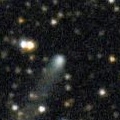
|
Now it is 15.6 mag (Nov. 5, Sandor Szabo). It stays 15-16 mag for a long time until 2021.
Date(TT) R.A. (2000) Decl. Delta r Elong. m1 Best Time(A, h)
Nov. 14 18 29.76 19 4.1 5.050 4.638 60 15.8 18:22 ( 85, 42)
Nov. 21 18 32.18 19 14.9 5.126 4.653 56 15.9 18:19 ( 88, 37)
|
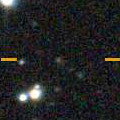
|
Now it is 16.7 mag (Nov. 9, Toshihiko Ikemura, Hirohisa Sato). It will brighten up to 13.5 mag from winter to spring in 2021. In the Northern Hemisphere, it stays observable in excellent condition. In the Southern Hemisphere, it stays extremely low until 2021 spring.
Date(TT) R.A. (2000) Decl. Delta r Elong. m1 Best Time(A, h)
Nov. 14 23 23.31 45 50.7 1.412 2.137 124 16.0 19:48 (180, 79)
Nov. 21 23 22.97 44 6.1 1.376 2.065 120 15.8 19:20 (180, 81)
|
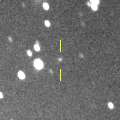
|
Now it is 15.4 mag (Nov. 4, Giuseppe Pappa). It is expected to brighten up to 13 mag in 2022. In 2020, it is observable in excellent condition in the Southern Hemisphere. In the Northern Hemisphere, it is observable from autumn to winter, but it locating extremely low.
Date(TT) R.A. (2000) Decl. Delta r Elong. m1 Best Time(A, h)
Nov. 14 8 31.86 -36 0.3 6.196 6.244 88 15.9 4:59 ( 0, 19)
Nov. 21 8 32.80 -36 48.5 6.093 6.205 91 15.9 4:32 ( 0, 18)
|
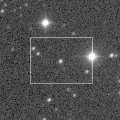
|
Now it is 15.1 mag (Nov. 9, Toshihiko Ikemura, Hirohisa Sato). It stays 15-16 mag until winter. In the Southern Hemisphere, it is observable in excellent condition. It will be getting higher graually after this also in the Northern Hemisphere.
Date(TT) R.A. (2000) Decl. Delta r Elong. m1 Best Time(A, h)
Nov. 14 21 55.01 -29 5.0 0.888 1.318 89 15.9 18:22 ( 0, 26)
Nov. 21 22 9.28 -23 27.4 0.901 1.304 87 15.9 18:19 ( 3, 32)
|

|
Now it is 16.3 mag (Nov. 9, Toshihiko Ikemura, Hirohisa Sato). It will brighten up to 14.5 mag from spring to summer in 2021. In the Southern Hemisphere, it stays observable in excellent condition for a long time. In the Northern Hemisphere, it is observable in good condition in 2020, however, it will be unobservable in 2021.
Date(TT) R.A. (2000) Decl. Delta r Elong. m1 Best Time(A, h)
Nov. 14 21 13.61 -29 3.4 3.130 3.123 80 15.9 18:22 ( 10, 25)
Nov. 21 21 13.42 -30 4.6 3.221 3.085 73 15.9 18:19 ( 16, 23)
|

|
Now it is 18.6 mag (Aug. 6, Palomar Mountain--ZTF). It will approach to Sun down to 0.14 a.u. on Dec. 7, and will brighten up to 11 mag. But it is not observable at the high light. It is observable until November when it brightens up to 16 mag.
Date(TT) R.A. (2000) Decl. Delta r Elong. m1 Best Time(A, h)
Nov. 14 12 15.48 -4 55.7 0.637 0.717 46 15.9 5:06 (297, 26)
Nov. 21 13 29.11 -14 35.8 0.678 0.561 33 16.1 5:12 (297, 12)
|
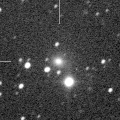
|
It brightened up to 13.5 mag in winter (Dec. 6, Chris Wyatt). Now it is fading slowly. Now it is 15.6 mag (Oct. 17, Martin Masek). In the Southern Hemisphere, it stays observable for a long time. It locates somewhat low in the Northern Hemisphere. Taras Prystavski found its fragmentation on Sept. 12.
Date(TT) R.A. (2000) Decl. Delta r Elong. m1 Best Time(A, h)
Nov. 14 1 41.34 -34 12.4 4.031 4.642 122 16.0 22:05 ( 0, 21)
Nov. 21 1 34.35 -32 59.3 4.131 4.682 118 16.1 21:30 ( 0, 22)
|
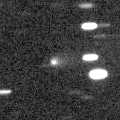
|
Now it is 15.7 mag (Oct. 20, Giuseppe Pappa). It stays 16 mag until winter, and observable in good condition. It locates somewhat low in the Southern Hemisphere.
Date(TT) R.A. (2000) Decl. Delta r Elong. m1 Best Time(A, h)
Nov. 14 8 37.78 17 28.5 1.792 2.253 104 16.2 5:05 ( 0, 72)
Nov. 21 8 41.23 17 35.8 1.745 2.290 110 16.3 4:41 ( 0, 73)
|
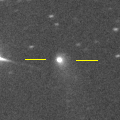
|
It brightened up to 13.8 mag in autumn in 2019 (Sept. 3, Chris Wyatt). Now it is fading slowly. It has already faded down to 16.5 mag (Nov. 8, Toshihiko Ikemura, Hirohisa Sato). But it is still bright visually as 14.8 mag (Nov. 5, Sandor Szabo).
Date(TT) R.A. (2000) Decl. Delta r Elong. m1 Best Time(A, h)
Nov. 14 23 45.37 2 23.7 5.993 6.620 125 16.3 20:10 ( 0, 58)
Nov. 21 23 43.85 2 35.0 6.135 6.662 118 16.3 19:41 ( 0, 58)
|
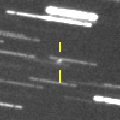
|
First return of a new periodic comet which brightened up to 17 mag in 2013. Now it is 17.7 mag (Oct. 26, Toshihiko Ikemura, Hirohisa Sato). It will brighten up to 16 mag and will be observable in good condition in winter. In the Southern Hemisphere, it locates low until December.
Date(TT) R.A. (2000) Decl. Delta r Elong. m1 Best Time(A, h)
Nov. 14 8 56.86 39 9.3 0.536 1.244 105 16.6 5:06 (219, 85)
Nov. 21 9 41.00 37 36.0 0.506 1.207 103 16.3 5:12 (244, 84)
|
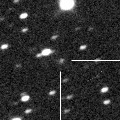
|
Now it is 16.4 mag (Nov. 9, Toshihiko Ikemura, Hirohisa Sato). It is observable at 16.5-17 mag from 2020 to 2021. In the Southern Hemisphere, it is not observable until summer in 2021.
Date(TT) R.A. (2000) Decl. Delta r Elong. m1 Best Time(A, h)
Nov. 14 22 5.99 61 24.4 5.559 5.996 111 16.5 18:30 (180, 64)
Nov. 21 22 4.27 59 30.6 5.590 5.989 109 16.5 18:19 (175, 65)
|

|
Now it is 16.6 mag (Nov. 9, Toshihiko Ikemura, Hirohisa Sato). It stays at 16-17 mag from 2020 to 2021.
Date(TT) R.A. (2000) Decl. Delta r Elong. m1 Best Time(A, h)
Nov. 14 18 59.56 29 26.1 9.106 8.844 71 16.8 18:22 ( 94, 52)
Nov. 21 19 1.42 29 21.8 9.163 8.841 68 16.8 18:19 ( 97, 48)
|
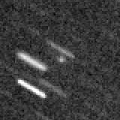
|
Now it is 17.3 mag (Oct. 23, ATLAS-HKO, Haleakala). It will approach to Earth down to 0.46 a.u. in 2021 April, and it is expected to brighten up to 12.5 mag and to be observable in excellent condition.
Date(TT) R.A. (2000) Decl. Delta r Elong. m1 Best Time(A, h)
Nov. 14 22 41.71 -22 30.0 1.524 1.972 101 16.9 19:05 ( 0, 33)
Nov. 21 22 20.11 -22 26.7 1.613 1.889 89 16.8 18:19 ( 1, 33)
|

|
First return of a new periodic comet which brightened up to 17.5 mag in 2012. Now it is 17.4 mag (Oct. 28, ATLAS-MLO, Mauna Loa). It stays observable at 17 mag in good condition from summer to winter. It locates somewhat low in the Southern Hemisphere.
Date(TT) R.A. (2000) Decl. Delta r Elong. m1 Best Time(A, h)
Nov. 14 5 11.48 38 2.4 1.611 2.507 148 17.0 1:40 (180, 87)
Nov. 21 5 5.69 38 28.0 1.598 2.527 154 17.1 1:06 (180, 87)
|

|
It was expected to brighten very rapidly, and brighten up to 14.5 mag from August to September. However, its current brightness is very uncertain. It could not be detected as fainter than 18.0 mag on June 30 (Charles S. Morris), and fainter than 15.7 mag on July 13 (Sandor Szabo). However, Giuseppe Pappa reported as 14 mag on July 10, and Thomas Lehmann reported it is bright as 15.2 mag on July 12. In the Northern Hemisphere, it stays observable for a long time. It is getting higher gradually after this also in the Southern Hemisphere.
Date(TT) R.A. (2000) Decl. Delta r Elong. m1 Best Time(A, h)
Nov. 14 10 44.05 -8 31.0 1.689 1.587 66 17.1 5:06 (320, 37)
Nov. 21 10 39.11 -13 5.5 1.662 1.674 73 17.3 5:12 (333, 38)
|
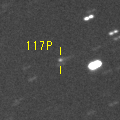
|
It will brighten up to 13 mag in 2022. In 2021, it is observable at 15-16 mag in good condition.
Date(TT) R.A. (2000) Decl. Delta r Elong. m1 Best Time(A, h)
Nov. 14 12 47.67 1 45.0 4.699 4.017 41 17.2 5:06 (285, 24)
Nov. 21 12 54.38 1 5.0 4.608 4.002 47 17.2 5:12 (291, 28)
|
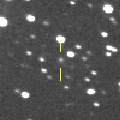
|
Now it is 17.1 mag (Nov. 8, Toshihiko Ikemura, Hirohisa Sato). It will brighten up to 17 mag in December. It is observable in good condition. It locates somewhat low in the Southern Hemisphere.
Date(TT) R.A. (2000) Decl. Delta r Elong. m1 Best Time(A, h)
Nov. 14 2 17.42 40 4.4 1.007 1.948 154 17.4 22:41 (180, 85)
Nov. 21 2 15.03 38 27.0 1.003 1.936 152 17.3 22:12 (180, 87)
|
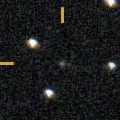
|
Now it is 17.1 mag (Oct. 25, D. Buczynski). It is observable at 17-18 mag for a long time from late 2019 to early 2021. It will fade out before it passes the perihelion.
Date(TT) R.A. (2000) Decl. Delta r Elong. m1 Best Time(A, h)
Nov. 14 5 58.68 16 53.9 3.715 4.532 141 17.4 2:26 ( 0, 72)
Nov. 21 5 55.93 17 2.8 3.645 4.522 149 17.4 1:56 ( 0, 72)
|
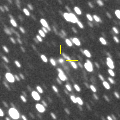
|
Now it is 17.3 mag (Nov. 9, Toshihiko Ikemura, Hirohisa Sato). It will be fading after this, and will be fainter than 18 mag in December.
Date(TT) R.A. (2000) Decl. Delta r Elong. m1 Best Time(A, h)
Nov. 14 21 24.65 -0 16.6 1.936 2.198 91 17.4 18:22 ( 14, 54)
Nov. 21 21 36.46 -0 38.9 2.023 2.211 87 17.5 18:19 ( 19, 53)
|
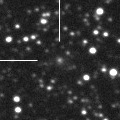
|
It brightened up to 14.6 mag in summer (July 18, Thomas Lehmann). Now it is 17.4 mag (Nov. 8, Toshihiko Ikemura, Hirohisa Sato). It stays observable until December when it becomes fainter than 18 mag.
Date(TT) R.A. (2000) Decl. Delta r Elong. m1 Best Time(A, h)
Nov. 14 20 58.03 -13 26.0 2.176 2.250 81 17.5 18:22 ( 19, 40)
Nov. 21 21 10.70 -13 7.3 2.277 2.274 77 17.6 18:19 ( 22, 39)
|

|
Now it is 17.2 mag (Oct. 25, A. Mickleburgh). It stays 15-16 mag for a long time from 2021 spring to 2022 spring. It stays observable for a long time in the Northern Hemisphere. In the Southern Hemipsphere, it is not observable until the end of 2021.
Date(TT) R.A. (2000) Decl. Delta r Elong. m1 Best Time(A, h)
Nov. 14 19 25.28 46 16.9 3.991 4.032 85 17.6 18:22 (123, 59)
Nov. 21 19 25.19 45 27.3 4.004 3.989 82 17.5 18:19 (121, 55)
|
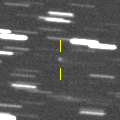
|
Now it is 17.0 mag (Nov. 9, Toshihiko Ikemura, Hirohisa Sato). It stays observable at 17.5-18 mag in good condition until winter.
Date(TT) R.A. (2000) Decl. Delta r Elong. m1 Best Time(A, h)
Nov. 14 7 53.09 17 53.3 1.527 2.141 114 17.7 4:20 ( 0, 73)
Nov. 21 7 55.67 18 20.4 1.483 2.169 121 17.7 3:55 ( 0, 73)
|

|
Now it is 17.6 mag (Oct. 15, Blue Mountains Observatory, Leura). It is expected to brighten up to 12 mag in 2022. In the Southern Hemisphere, it stays observable in good condition for a long time. In the Northern Hemisphere, it is not observable until 2022.
Date(TT) R.A. (2000) Decl. Delta r Elong. m1 Best Time(A, h)
Nov. 14 3 55.41 -49 9.7 6.283 6.718 112 17.8 0:23 ( 0, 6)
Nov. 21 3 47.56 -49 43.4 6.260 6.669 110 17.7 23:43 ( 0, 5)
|

|
Now it is 18.0 mag (Nov. 3, Giuseppe Pappa). It stays 18 mag until November. It is observable in excellent condition in the Southern Hemisphere. It locates very low in the Northern Hemisphere.
Date(TT) R.A. (2000) Decl. Delta r Elong. m1 Best Time(A, h)
Nov. 14 23 6.88 -35 2.0 2.816 3.147 100 17.9 19:32 ( 0, 20)
Nov. 21 23 10.50 -34 22.1 2.907 3.150 94 17.9 19:08 ( 0, 21)
|

|
New comet discovered in the images of SOHO spacecraft. It approached to Sun down to 0.09 a.u. on Aug. 8, and it brightened up to 3 mag. Appearing in the morning sky, but it must be fainter than 18 mag.
Date(TT) R.A. (2000) Decl. Delta r Elong. m1 Best Time(A, h)
Nov. 14 11 22.18 -6 25.6 2.615 2.260 58 19.6 5:06 (309, 33)
Nov. 21 11 24.53 -6 57.7 2.620 2.371 64 19.8 5:12 (317, 38)
|
|
![]()
 C/2019 U6 ( Lemmon )
C/2019 U6 ( Lemmon ) 17P/Holmes
17P/Holmes C/2018 U1 ( Lemmon )
C/2018 U1 ( Lemmon ) C/2019 K7 ( Smith )
C/2019 K7 ( Smith ) C/2020 N1 ( PanSTARRS )
C/2020 N1 ( PanSTARRS ) C/2019 T4 ( ATLAS )
C/2019 T4 ( ATLAS ) 162P/Siding Spring
162P/Siding Spring C/2019 T2 ( Lemmon )
C/2019 T2 ( Lemmon ) (3200) Phaethon
(3200) Phaethon C/2018 F4 ( PanSTARRS )
C/2018 F4 ( PanSTARRS ) 84P/Giclas
84P/Giclas C/2017 B3 ( LINEAR )
C/2017 B3 ( LINEAR ) P/2020 U1 ( Lemmon )
P/2020 U1 ( Lemmon ) C/2019 T3 ( ATLAS )
C/2019 T3 ( ATLAS ) C/2019 O3 ( Palomar )
C/2019 O3 ( Palomar ) C/2020 R4 ( ATLAS )
C/2020 R4 ( ATLAS ) 397P/2020 M2 ( Lemmon )
397P/2020 M2 ( Lemmon ) C/2020 H4 ( Leonard )
C/2020 H4 ( Leonard ) 117P/Helin-Roman-Alu 1
117P/Helin-Roman-Alu 1 277P/LINEAR
277P/LINEAR 173P/Mueller 5
173P/Mueller 5 257P/Catalina
257P/Catalina 115P/Maury
115P/Maury C/2020 M5 ( ATLAS )
C/2020 M5 ( ATLAS ) 178P/Hug-Bell
178P/Hug-Bell C/2020 R7 ( ATLAS )
C/2020 R7 ( ATLAS ) 254P/McNaught
254P/McNaught C/2020 P4 ( SOHO )
C/2020 P4 ( SOHO )![]()









































